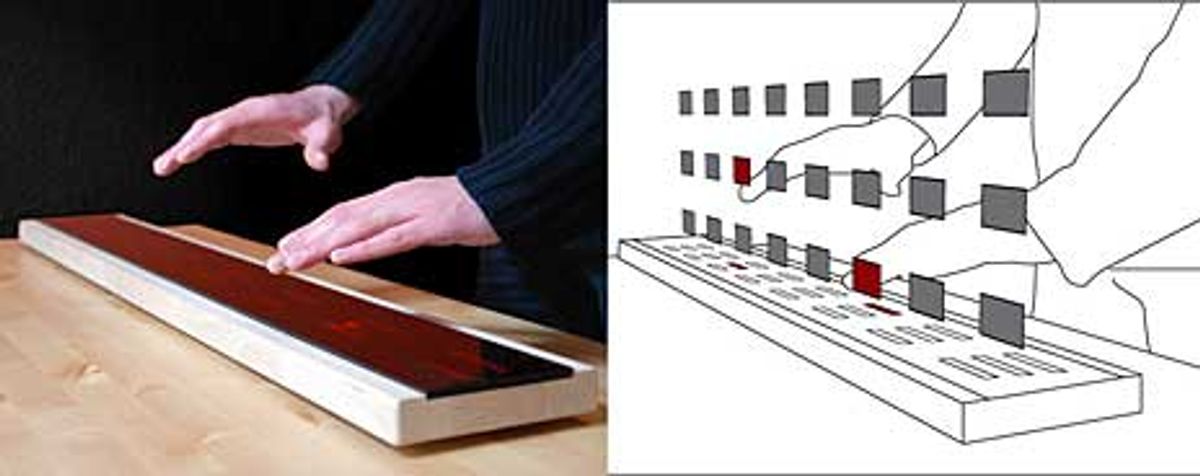11 November 2009—Omer Yosha is a formally trained musician who plays guitar and sings. He left his home near Tel Aviv to see the world, traveling dusty paths in India and busking in the streets of London before settling in Berlin. The German capital is wide open, its energetic art and design scene spurred by a polyglot, multidisciplinary mix-and-match mind-set and cheap space.
Yosha still plays, but along the way he enrolled in a local design-studies program, dropping by chance into a seminar on human-computer interaction. Hacking electronic instruments and following a bent toward design and interactivity fired his imagination for what could be done to create interfaces. Now, backed by some basic training in electrical engineering and experiments in rapid prototyping, he’s starting to see results.
Most notable is his AirPiano, a thin black piece of flat Plexiglas and wood that Yosha plays with a wave of his hand, his sounds and rhythms echoing those of the Schöneberg neighborhood in which he lives. (To sample them, watch this video.)
”It’s fascinating to trigger notes in the air,” Yosha says, tones from a third-generation prototype echoing in his studio. He is now working with an electrical engineering partner to build out some new design features, and he expects to offer AirPianos for custom order after the start of the new year.
The AirPiano works with 16 infrared proximity sensors built into the flat rectangular instrument, which has a USB jack and an Arduino microcontroller. A designer need only write a short bit of code for the Arduino to get something blinking or moving. When the player touches an invisible matrix above the instrument, it responds with sound. The shape of the matrix is programmed with his nearby laptop, and his gestures over the piano send a signal to the machine.
On the flat board, there are eight channels and three virtual keys above each. The instrument can be programmed to play any number of scales. An LED on the board lights up as long as a key is triggered, creating a simple feedback loop.
The AirPiano recalls the theremin, an 80-year-old pioneering analog instrument invented by the Soviet scientist Leon Thérémin (who can still be found on YouTube displaying his invention). You might know its flowing tone from any number of B-movie sci-fi tracks, or from the whistling spacey tune in the Beach Boys’ ”Good Vibrations,” or from Moog-distributed home kits. Yosha is a theremin fan. His digital strip, however, can deliver a punchy, clipped kick of a note as well as a sustained flow. He is working to integrate the velocity of a player’s movements into his sound kit.
”I like concepts that involve simple interaction, but in the end you have something you can really play as an instrument,” he says. His design ideas are about ease of use and simplicity, and the tools he uses at his designer’s bench reflect that—speakers, an iPhone, a laptop, a soldering iron, and a box of metal film resistors. The AirPiano happens to be an instrument, but it is more rightly seen as a trigger of sound. It could be used to trigger anything.
Yosha did the same sort of work in an early project, where he cut the bottom out of an athletic shoe, wired the sole with three switches hooked into a drum machine, and presto: the drum shoe. ”These are objects, surfaces, but with them you can control sounds,” he says.
The shoe manipulates three different beats or types of sounds. With the AirPiano, Yosha wanted to keep a simple matrix but also do more. He points out that a nightclub DJ rarely interacts with a dancing crowd, instead poring over monitors and turntables. If the AirPiano is hooked into MIDI (musical instrument digital-interface software), it can be used to trigger samples, beats, sounds, and notes—with visual flair. ”It’s interesting to watch,” he says. ”You can be in motion and still control things.”
About the Author
Michael Dumiak is a freelance journalist based in Berlin who writes about technology and society.
Michael Dumiak is a Berlin-based writer and reporter covering science and culture and a longtime contributor to IEEE Spectrum. For Spectrum, he has covered digital models of ailing hearts in Belgrade, reported on technology from Minsk and shale energy from the Estonian-Russian border, explored cryonics in Saarland, and followed the controversial phaseout of incandescent lightbulbs in Berlin. He is author and editor of Woods and the Sea: Estonian Design and the Virtual Frontier.




